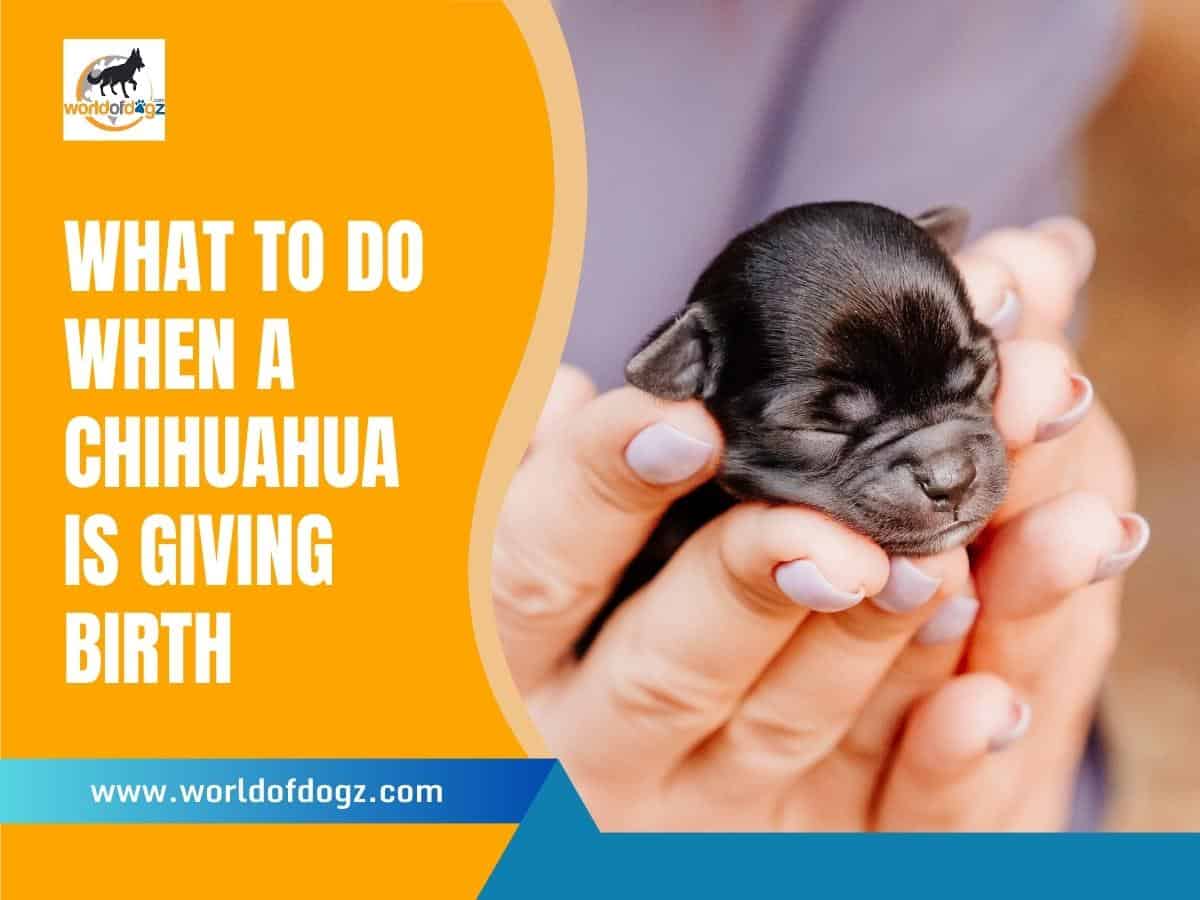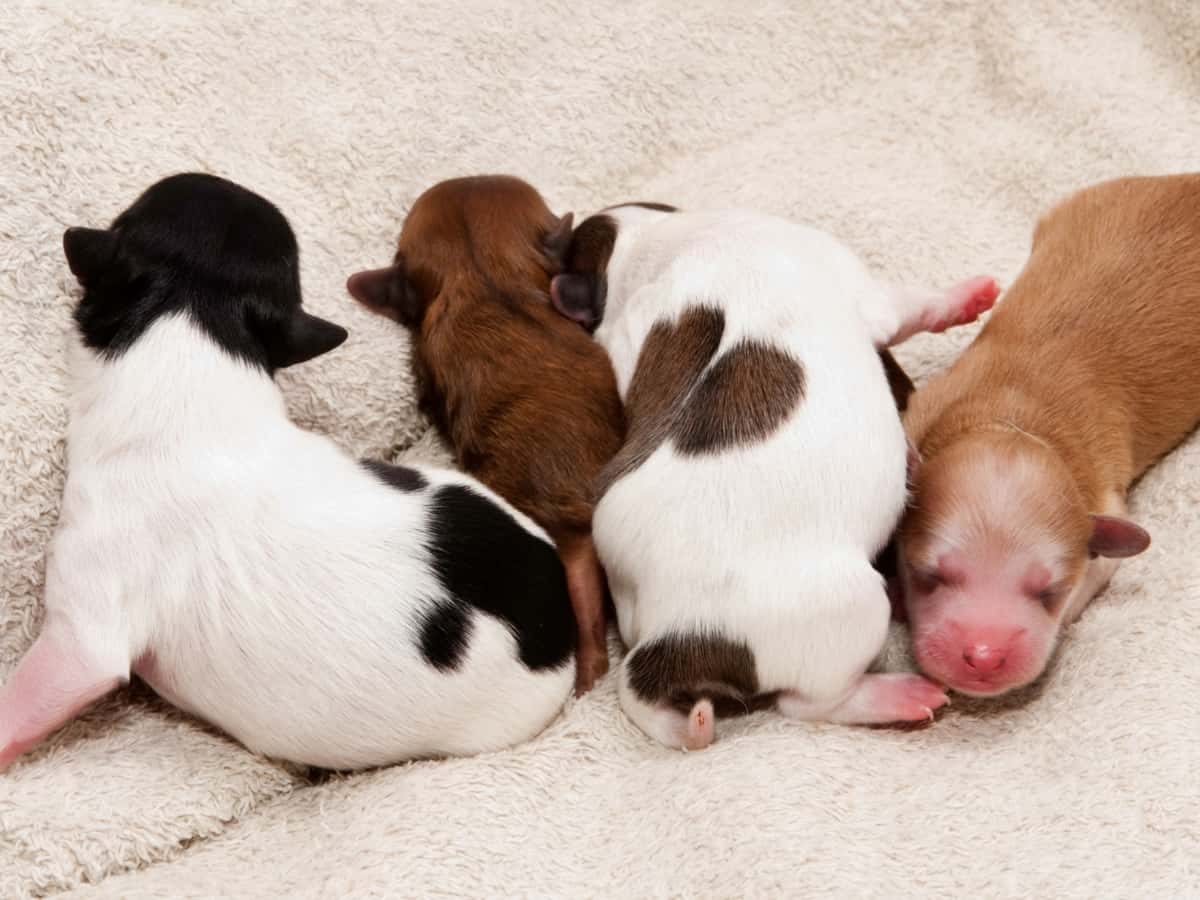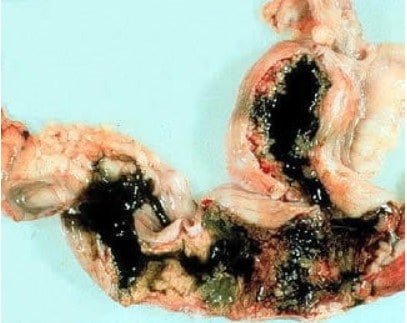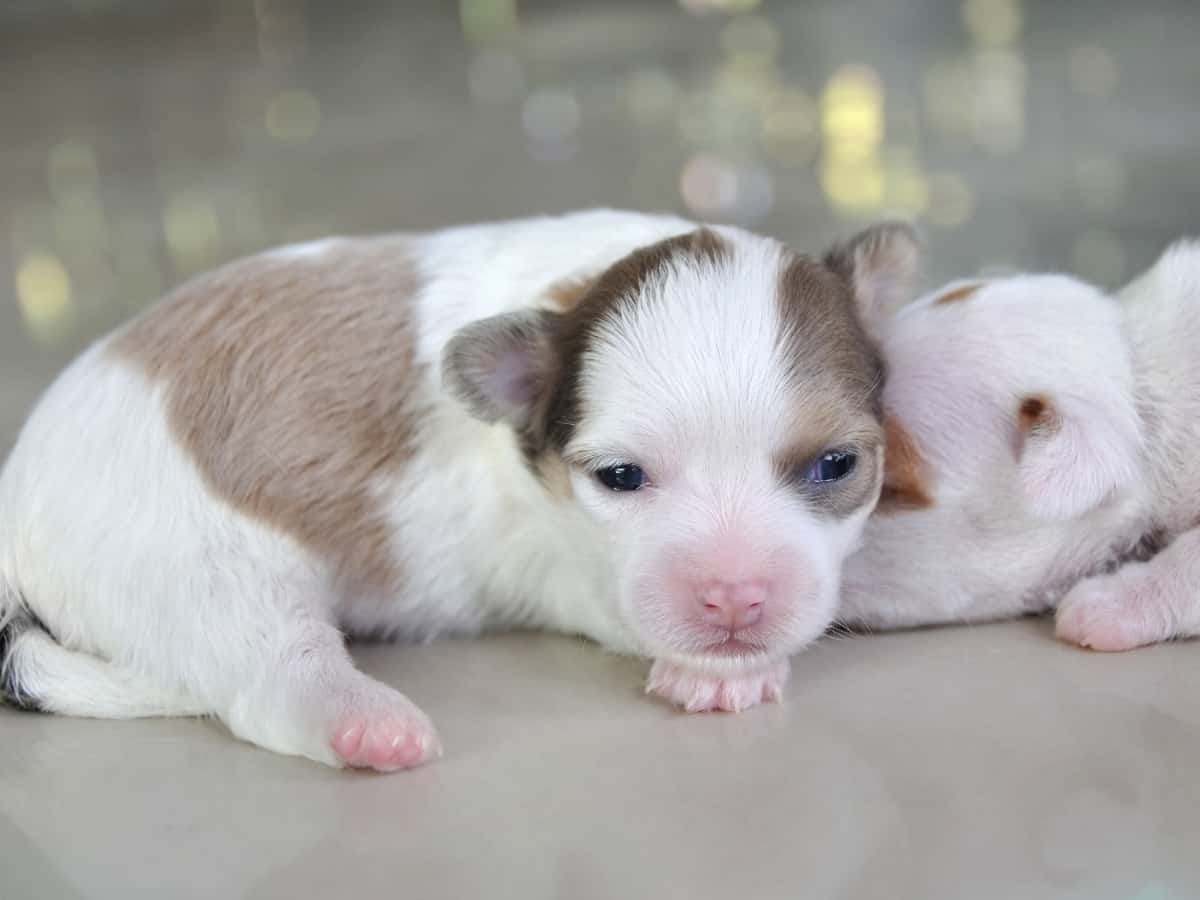Welcoming a new litter of Chihuahua puppies into the world can be an exciting and nerve-wracking experience. Having been with a Chihuahua from conception to reproduction, I’ve observed how this breed has various needs during labor.
Do you own a Chihuahua? If yes, you need a checklist on what to do when your little Chihuahua is giving birth.
During the birthing process, your primary role is to offer support, comfort, and a clean environment for your Chihuahua. Be prepared with essential supplies such as clean towels, a heating pad, and a whelping box. Observe your dog closely for any signs of distress, and contact a vet if complications arise.
Are you witnessing a Chihuahua’s pregnancy for the first time? Here’s a detailed guide with step-by-step information to address the care needs of your Chihuahua while giving birth.

How to Prepare When Your Chihuahua Is Giving Birth
The pregnancy period of a Chihuahua is critical. As a toy dog breed, Chihuahuas are vulnerable to a wide range of pregnancy complications, especially if it’s their first pregnancy. Hemolytic anemia is one common complication. Other issues include miscarriage, dystocia, amniotic sac and umbilical problems.
Did you know that the preparation phase can influence the puppy’s health?
When my friend’s Chihuahua was about to give birth, she had a checklist ready with pre, during, and post-birth stages. I’d strongly recommend you do the same!
Here’s what you should do in the preparation phase.
Consult a Vet
Before your Chihuahua gives birth, you must consult with a veterinarian. They can guide the birthing process, ensuring your dogs’ and the puppies’ safety and comfort. Further, a vet will conduct rectal and vaginal examinations to determine potential issues.
Schedule a prenatal checkup to confirm the pregnancy, estimate the due date, and discuss any specific needs.
You can also use this helpful calculator to estimate the dam’s due date:
Prepare a List of Supplies
To ensure a smooth birthing process and provide adequate care for your Chihuahua and her puppies, gather the following supplies:
Whelping Box and Mat
To prepare for whelping Chihuahua puppies, a whelping box or mat will be required for the newborns to rest comfortably after birth while their mother recovers. The mother will instinctively know when it’s time to nurse and cuddle her litter, but the puppies will require a warm and secure environment to sleep and snuggle with each other when she’s not available.
While towels and blankets may suffice, a whelping mat is helpful to ensure the puppies’ comfort. There’s no need to spend much money on a whelping box, as a basket or DIY cardboard box can be suitable.
Clean Towels or Blankets, Warm Water & Mild Soap
You will want to have some of the blankets around the dam. They will help keep her warm and feel safe and secure. If she has a favorite blanket that she loves to snuggle up with, use that. However, you’ll also need additional towels and blankets for the little pups after birth. A pile of Chihuahua puppies bundled up with Mom surrounded by comfort blankets is also just really cute.
Sterilized Pair of Scissors & Gloves, Thread, and Antiseptic Solution
Typically, the dam will sever the umbilical cord by biting through it. But if she doesn’t, you must cut the cord using sterilized scissors.
Cut about an inch from the newborn’s belly and then use the thread to tie off the cord about ½ inch from the stomach. Once tied off, ensure the end of the cord is cleaned with antiseptic. Cleanliness during this is vital, so a pair of medical gloves and a clean workspace are essential.
Bulb Syringe
Sometimes newborn puppies have built-up mucus around their nose, which causes breathing troubles. The mom will do her best to lick it away, but if you see one of the tiny Chihuahua puppies still struggling with taking breaths, you must have a baby nose suction bulb, such as this one from Amazon, ready to go.
Swaddle the puppy gently, carefully suck the mucus out with the bulb, and then hold the pup while gently rubbing its chest.
Digital Thermometer and Indoor/Outdoor Thermometer
You will need a digital thermometer to monitor the mom’s temperature before and after pregnancy to ensure she is doing okay. You will also need to check the puppies’ temperatures if you believe one may be sick or if anything doesn’t seem right.
The indoor/outdoor thermometer will help to check that the room, particularly the whelping box area with the puppies, is warm enough. According to VCA Hospitals, where the puppies are kept should be between 85-90 degrees for the first four days. Then decrease the temperature to 80 degrees by the 7th – 10th day and 72 degrees by the end of the fourth week.
Heating Pad
Newborn Chihuahua puppies are incapable of regulating their body temperature. The mother dog is aware of this and will try to keep her pups warm by using her body temperature and snuggling with them. However, it is advisable to have a heating pad or lamp on standby to maintain warmth in the area where the newborns are kept.
If you use a heating pad, you can put it under the blankets and towels where the puppies are resting. I like the RIOGOO Pet Heating Pad from Amazon as it has an auto power-off if the pad becomes too hot. It also has loads of temperature and timer settings, giving you plenty of options.
If you choose to use a lamp, ensure it is positioned far away from the puppies to avoid overheating or burning them. Personally, I’d use a heating pad as it seems to be the safer choice.
Baby or Puppy Scale
It’s essential throughout the puppies’ early stages that they gain weight at a healthy pace. Chihuahua puppies generally range from 2.5 ounces to 6.5 ounces at birth, depending on their parent’s size.
You should measure their weight early to begin monitoring their growth journey, which is an essential step toward proper health.
Prepare a List of Emergency Supplies
Additionally, you should have an emergency supply kit on hand in case complications arise:
- Emergency contact information for your veterinarian
- Injectable oxytocin and calcium gluconate (as advised by your veterinarian)
- Oral glucose paste for low blood sugar
- Puppy milk replacer and nursing bottles
- Soft travel crate should you need to transport the mom to the vet

Checklist:
- Clean towels or blankets
- Whelping box and mat
- Warm water and mild soap
- Thread and antiseptic solution
- Sterilized scissors
- Sterilized gloves
- Bulb syringe
- Digital thermometer
- Indoor/outdoor thermometer
- Baby or puppy scale
- Heating pad
- Puppy milk replacer and nursing bottles
- Emergency contact info
- Injectable oxytocin and calcium gluconate
- Oral glucose paste
- Soft travel crate
Ensure a Clean and Comforting Environment
Create a comfortable and clean environment for your Chihuahua to give birth in. Choose a quiet, secluded area of your home, away from noise or activity. Set up a whelping box with soft bedding for your Chihuahua to nest in. Clean the area thoroughly and remove any potential hazards.
Keep the room temperature warm, as Chihuahua puppies can’t regulate their body temperature sufficiently. Ensure the area remains clean, and change the bedding regularly to maintain a sanitary environment for your dog and her new puppies.
How To Help a Chihuahua Give Birth
You should be prepared and knowledgeable when your Chihuahua is about to give birth.
“Honestly, this isn’t a beginner-friendly phase and you need an expert next to you!”
Here are the steps you should take and some potential issues, signs, and solutions to help you along the way.
- Set up a comfortable birthing area: Provide a comfortable and quiet space for your Chihuahua to give birth. This can be a crate, a box, or a designated area in your home with soft blankets or towels.
- Keep track of your Chihuahua’s due date: Keep a record of your Chihuahua’s mating date so you know the approximate due date. This will help you monitor signs of labor.
- Monitor signs of labor: As your Chihuahua approaches her due date, watch for signs that delivery is imminent. These include nesting behavior, panting, pacing, shivering, and a drop in body temperature.
Potential Issues and Solutions
Even when you give the utmost care, some Chihuahuas may become weak and experience issues during pregnancy.
| Issue | Solution |
|---|---|
| Stalled labor: If your Chihuahua has strong contractions for more than an hour without giving birth to a puppy, this may be considered stalled labor. | Contact your veterinarian immediately if your Chihuahua has been in active labor for more than 2 hours without delivering a puppy. They may recommend inducing labor or performing a C-section. Stalled labor can signify fetal distress, and delaying treatment can be life-threatening for both the mother and puppies. |
| Retained placenta: After each delivery, the mom should expel the placenta. | A retained placenta can cause infection, sepsis, and other life-threatening complications. Your veterinarian may need to perform a procedure to remove the placenta or prescribe medication to help the uterus contract and expel it. |
| Inability to cut the umbilical cord: Your Chihuahua should naturally bite through each puppy’s umbilical cord after birth. If she doesn’t, you’ll need to intervene. | Sterilize a pair of scissors and carefully cut the umbilical cord about an inch away from the puppy’s body. Tie the remaining cord with a piece of sanitized thread to prevent bleeding. Leaving the umbilical cord attached for too long can cause infection or other complications. |
MSD Veterinary Manual has given an outlook of retained placenta and the development of green lochia after 48 hours of whelping.
This image will give you a better picture of what exactly happens.

How Long Does it Take a Chihuahua to Give Birth?
A Chihuahua giving birth, or the birthing stage, typically takes around a few hours when labor begins. However, this duration may vary depending on certain factors, such as the number of puppies born, the mother’s overall health, and whether it is her first time giving birth.
To help your Chihuahua during this process, it’s essential to be aware of the different stages of labor:
- Stage 1 – Nesting and contractions: Your Chihuahua will start looking for a safe and comfortable spot to give birth. This stage can last anywhere between 6 – 24 hours. You may notice her panting and pacing while experiencing contractions.
- Stage 2 – Birth of the puppies: During this stage, your Chihuahua will deliver her puppies. It usually takes about 30 minutes to an hour between each puppy’s birth, but it may take longer in some cases. You’ll need to be patient and prepared to offer assistance if required.
- Stage 3 – Delivery of the placenta: After each puppy is born, your Chihuahua will deliver the placenta. Ensure she cleans her puppies properly (licking them to stimulate breathing and remove birth fluids). She will then eat the placenta, which provides vital nutrients.
Keep a close eye on your Chihuahua, but giving her some space is essential to ensure she isn’t stressed. Here’s a brief table to summarize the stages of labor:
| Stage | Description | Duration |
|---|---|---|
| 1 | Nesting and contractions | 6 – 24 hours |
| 2 | Birth of the puppies | 30 minutes – 1 hour (per puppy) |
| 3 | Delivery of the placenta and cleaning of the puppies | Following each birth |
Here’s Eggo, the pregnant Chihuahua that has given birth to 8 puppies. It’s informative and pleasant to watch the birth of new lives.
How Many Puppies Can a Chihuahua Have the First Time?
When your Chihuahua is expecting, it’s natural to be curious about how many puppies she might have during her first litter. Typically, a Chihuahua can give birth to 1 to 3 puppies in her first litter, though this can vary.
The American Kennel Club states that the litter size is proportional to the dog’s size.
Remember that factors like your Chihuahua’s age, size, and overall health can influence the size of her litter. Genetics may also play a role, so if you have information on her lineage or previous generations, this could give you insight into the potential number of puppies.
So, how do you know if it’s time for your Chihuahua to give birth?
Here are some indicators to watch for:
- Contractions: You’ll notice your Chihuahua’s abdomen contracting or tightening, signaling she’s pushing out the next puppy.
- Restlessness: She might become more restless and anxious, indicating that another puppy is on the way.
- Position Change: Your Chihuahua could change her position frequently, trying to find a comfortable posture to deliver the next little one.
- Heavy Panting and Shivering: As labor intensifies, her panting may increase, and she may shiver as she prepares for the next delivery.
Post-Pregnancy Plan for a Chihuahua
Congratulations on your Chihuahua’s puppies! It’s an exciting time, but it’s also essential to be prepared for after the birth. Here are some post-pregnancy plans to ensure your Chihuahua and her puppies get the best care possible.
Caring for the Mother
Ensure your Chihuahua gets all the nutrients and hydration she needs after giving birth. As a new mother, she’ll need extra care and attention. Provide her with the following:
- A high-quality dog food formulated explicitly for nursing dogs. If they’re picky, discover ways to get them to eat properly.
- Fresh water available all the time
- A comfortable place to rest and nurse her puppies
- Regular checkups with the veterinarian to ensure her health
Caring for the Puppies

Chihuahua puppies are tiny and delicate, so caring for them is crucial. Ensure their safety and well-being:
- Keep them warm: Chihuahuas are prone to cold, so providing a cozy and warm environment is essential.
- Monitor their feeding: Ensure they’re latching on and nursing well; if any pup struggles, seek expert advice.
- Socialization: Gradually introduce the puppies to new sights, sounds, and people to help them grow into confident and friendly dogs.
- Vaccinations: Follow your veterinarian’s vaccination plan for the puppies.
Preparing for New Homes
It’s essential to plan for the puppies’ new forever homes. Here is an ideal plan:
- Begin screening potential adopters once the puppies are a few weeks old.
- Set up an adoption application process with questions about adopters’ experience, living arrangements, and commitment to the puppies’ lifelong care.
- Schedule meet-and-greets with interested adopters.
- Prepare take-home kits for each puppy, including toys, food samples, and tips for the new owner.
- Set a date for the puppies to transition to their new homes, ideally around 8-10 weeks of age.
Having a solid post-pregnancy plan lets you enjoy watching your Chihuahua and her puppies thrive and grow before they venture off to their new forever homes. Remember, your care and commitment make a real difference in their lives!
Final Thoughts
The birth process of Chihuahua comes with a need to take care of their environment, nutrition level, physiological conditions, and much more. With frequent vet checkups, you may have to prioritize every sign of your dog’s body language to become extra cautious.
Give the new family a quiet space as soon as your Chihuahua has given birth. Offer excellent care and they will thank you for being instrumental in their happy birthing!






